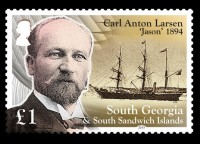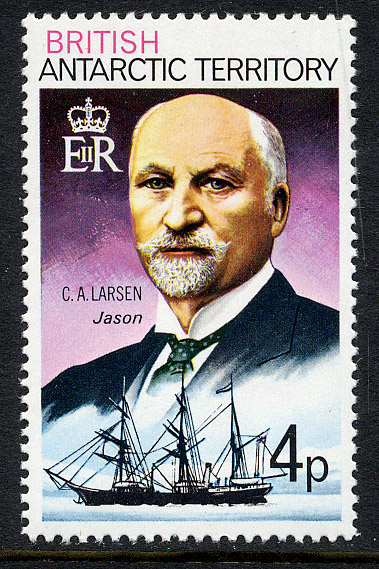Post
by aukepalmhof » Fri Apr 17, 2009 9:52 pm
The seal catcher was built by the Rødsvaerven at Sandefjord, financed by Christen Christensen, Sandefjord.
Launched under the name JASON.
Tonnage 495 tons gross, 255 net, dim. 147 x 30 x 17.1ft.
One auxiliary steam engine of 60 ihp.
Barque rigged.
1881 Completed.
1889 She was sold to Oceana, managed by Christen Christensen, at that time the largest seal and bottlenose company in Norway.
When Christensen was looking for whales in the more southerly waters the JASON was chosen for an expedition to these waters, she was one of the most solid built vessels in his fleet, easy to manoeuvre.
Capt C.A. Larsen was appointed master, and expedition leader.
04 September 1892 the ship set sail from Sandefjord with orders to look at the possibilities of catching seal or right whales in the Antarctic seas.
07 November South Georgia was passed and course was set for the South Orkney Islands and the Antarctic Peninsula.
She cruised for a few weeks around penetrating the Weddell Sea as far as 64º south, looking for right whales the only whales the Jason could handle, at that time whalebone was very expensive a ton of bone was worth £2.500, a large right whale could yield one ton of bone. Many whales were seen very near to the vessel, but not any right whale.
At least Larsen cached 6.335 seals and two bottlenose whales to fill his holes with blubber and sail back to Sandefjord where she arrived 09 June 1893.
Most time was spent on the passage to and from the Antarctic, and the voyage was financially not a good one, the books were closed with a loss of 36.983 NKr. on the voyage.
While it did look a fiasco, not all was so bad, Larsen made extensive geographical studies during the voyage in the Antarctic, two of the crew were the first persons to set foot on the volcanic Seymour Island, also a collection of fossils was brought home from the Antarctic.
After the financially loss of the first expedition, enthusiasm for a second expedition was not great, but Larsen with the help of Carl Lindberg decided to send a larger expedition south, increasing the fleet from one to four ships.
When the fleet sailed from Norway between late May and early August 1893 the fleet comprised of the JASON under command of Larsen, the HERTHA of 164 tons, CASTOR 317 tons, both sealers, and a depot ship the iron barque ØRNEN. All together with a total crew of around 100 men.
End November the fleet was due to a very ice free season very deep in the Weddell Sea and sailed to the Antarctic Peninsula as far south of 66 40S 59 49W discovering on 01 December 1893 King Oscar II Land, 03 December they discovered Foyns Land and by 6 December the ships had reached 68 10S 59 59W, before they returned, on the return voyage she named the Larsen Ice Shelf, Robertson Island, Lindenberg Sukkertoppen and Christensen Volcano.
11 December Larsen together with his first officer Søren Andersen made the first documented landing and ski run on the continent of Antarctic when she traveled inland of Christen Christensen Island.
Shortly thereafter five small islands were discovered which she named Jason, Hertha, Castor, Larsen and Oceana.
Larsen had received a report that right whales where seen off Cape Horn in the early part of the year, and the fleet headed north to investigate.
When at Ushuaia, Chile for bunkers some of the crew deserted for the gold fields in South America. From Ushuaia the fleet headed for the Falklands to transfer the sealskins and blubber oil to the storeship ØRNEN. During the voyage she searched for the right whale but not one was sighted.
In the Falkland some rebellious crewmembers were put onshore, and after two days the fleet sailed out again.
23 January the ships were at Erebus and Terror bay after a stormy passage from the Falklands. Seals were abundant, and large numbers were killed, keeping the men busy 16 hours a day. At that time three men lost there live when there overloaded boat with seal capsized, also there was an outbreak of scurvy. On the return trip to the Falklands she cached more seals along the coast of Graham Land in February, before she on 15 March arrived in the Falklands.
In Port Stanley Larsen received a message from Christensen when the crew was willing they had to search for the right whale around South Georgia.
In the meantime the sealskins and blubber were transferred to the ØRNEN, and after the crew agreed for an other voyage to the Antarctic the fleet sailed from Port Stanley on 10 April arriving off South Georgia 19 April.
A great number of fin and humpback whales were seen but not any right whales. Larsen visited some of the bays on the island and the information he gathered there was very important for his later voyages to this island. He made calls at Royal Bay and Moltke Harbour.
Both the JASON and CASTOR harpooned a whale in April, but both were lost.
05/06 July 1894 the expedition arrived in Sandefjord with a large cargo of sealskins and blubber, the JASON got on board 6.637 sealskins and 800 barrels blubber, and the HERTHA and CASTRO combined brought in 6.586 sealskins and 300 barrels blubber. The ØRNEN was not so lucky during her return voyage loaded with 13.000 sealskins and 3.000 barrels she collided off Dover with a steamship, and finally was condemned in London, some of her cargo was saved.
The expedition was however a financial loss, and for the time being not a new expedition sailed from Norway for the Antarctic.
The JASON was sold in 1898 to Prince Luigi Amado, Duke of Abruzzi an Italian (he was the son of the King of Italy), after a refit and rerigged as barkentine she was renamed in STELLA POLARE.
Under Italian flag her tonnage is given as 495 gross, 255 net, dim. 41.80 x 7.90 x 3.90m. (draught)
The Duke needed the ship for his planned expedition to the Arctic.
12 June 1899 she sailed from Christiana (Oslo) with a crew of 24 men (other sources give 18 or 26 men), 11 Italian, 4 Norwegian guides, 1 cook, 8 Norwegian sailors and provision for four years on board, for an expedition to the north of Franz Josef Land under command of Capt. Cagni. Overall command of the expedition was in the hands of Prince Luigi Amado, Abruzzi.
She mad a call at Archangel, Russia, where they took on board 121 Russian sledge dogs, sailed from there on 12 July.
After she sailed through the British Channel she headed for Crown Prince Rudolf Land, they wintered in Teplitz Bay (81 48N 57 56E.), where the STELLA POLARE during the autumn almost wrecked. Most of the wintertime the crew stayed ashore in temporarily erected buildings; Prince Luigi Amado suffered badly from frostbite.
11 March 1900 three sledge parties of together thirteen men under command of Capt. Cagni left the STELLA POLARE in a northerly direction, after a difficult trip only Capt. Cagni his party reached a position 86 31N, the most northern position till that time ever reached, not possible to go farther north, they returned to the STELLA POLARE. The group leaded by Querini was lost and not heard from again.
The other two groups arrived back in Teplitz on 10 June 1900
16 August 1900 the STELLA POLARE sailed back to Norway and arrived on 05 September at Hammerfest.
Later she sailed to Italy.
19 Nov. 1900 transferred to the Italian Navy and used under the name STELLA POLARE as transport.
Displacement given as 1.289 tons.
April 1911 stricken from the navy list.
The same year donated to the City of Rome, to serve as an accommodation vessel for abandoned children in Rome.
She never arrived in Rome, her draught was to deep to sail upstream the River Tevere, and she was abandoned at Ripa Grande, later berthed at Fiumicino.
1920 Returned to the Italian navy. Sold at an auction to Ettore Serra at La Spezia, the proceeds of the auction were donated to the abandoned children in Rome.
Nov. 1920 she was donated to the Lega Nanale Italiana, with the intention to raise funds for her restoration.
In 1943 or 44 was she destroyed during an Allied air raid on Genoa.
Carl Anton Larsen is featured on the £1 stamp with the vessel JASON which be briefly brought to South Georgia in 1894 during a whaling cruise to the Antarctic.
Source: South Georgia Post
South Georgia & Sandwich Islands 2015 £1.00 sg?, scott?
Sources: Pesca by Ian B Hart. Navicula. Some websites. Info received from Mr. Alex Borgogno.
-
Attachments
-

-


